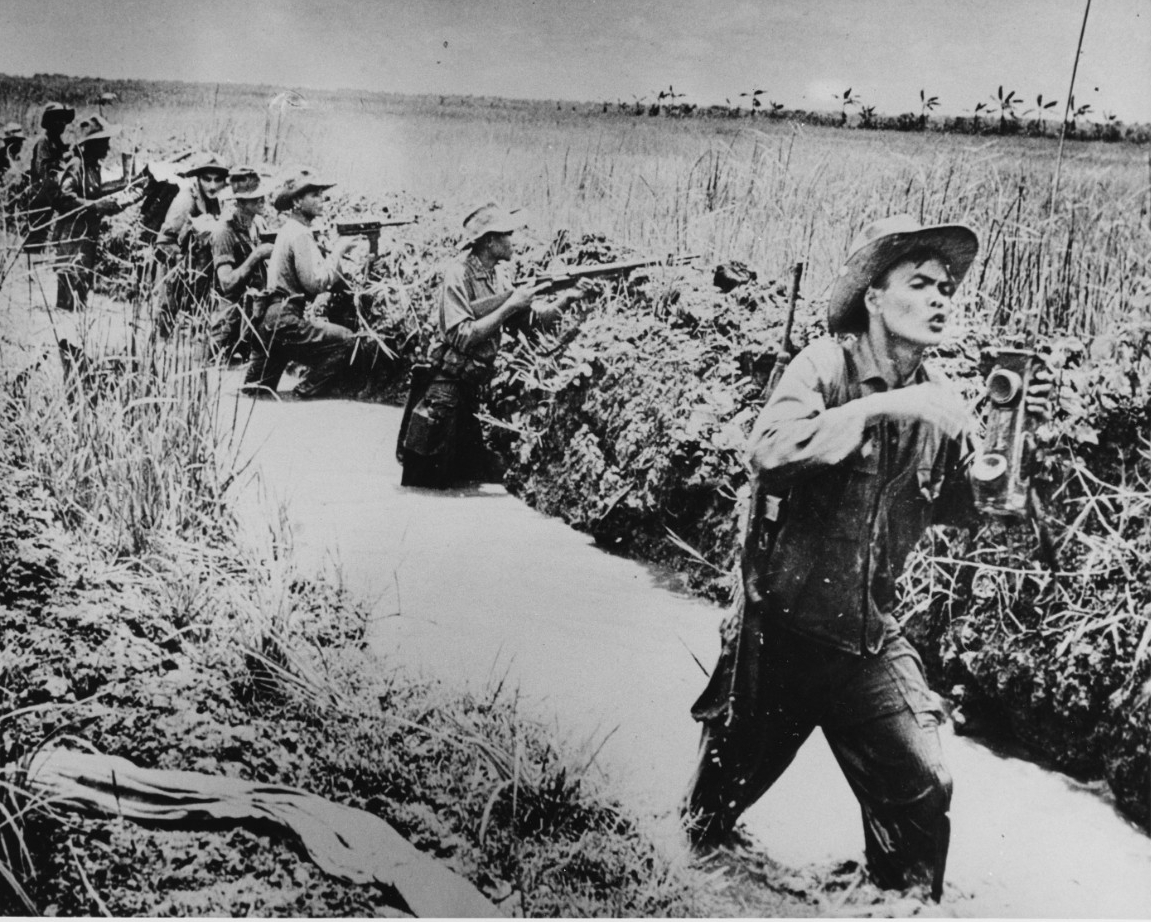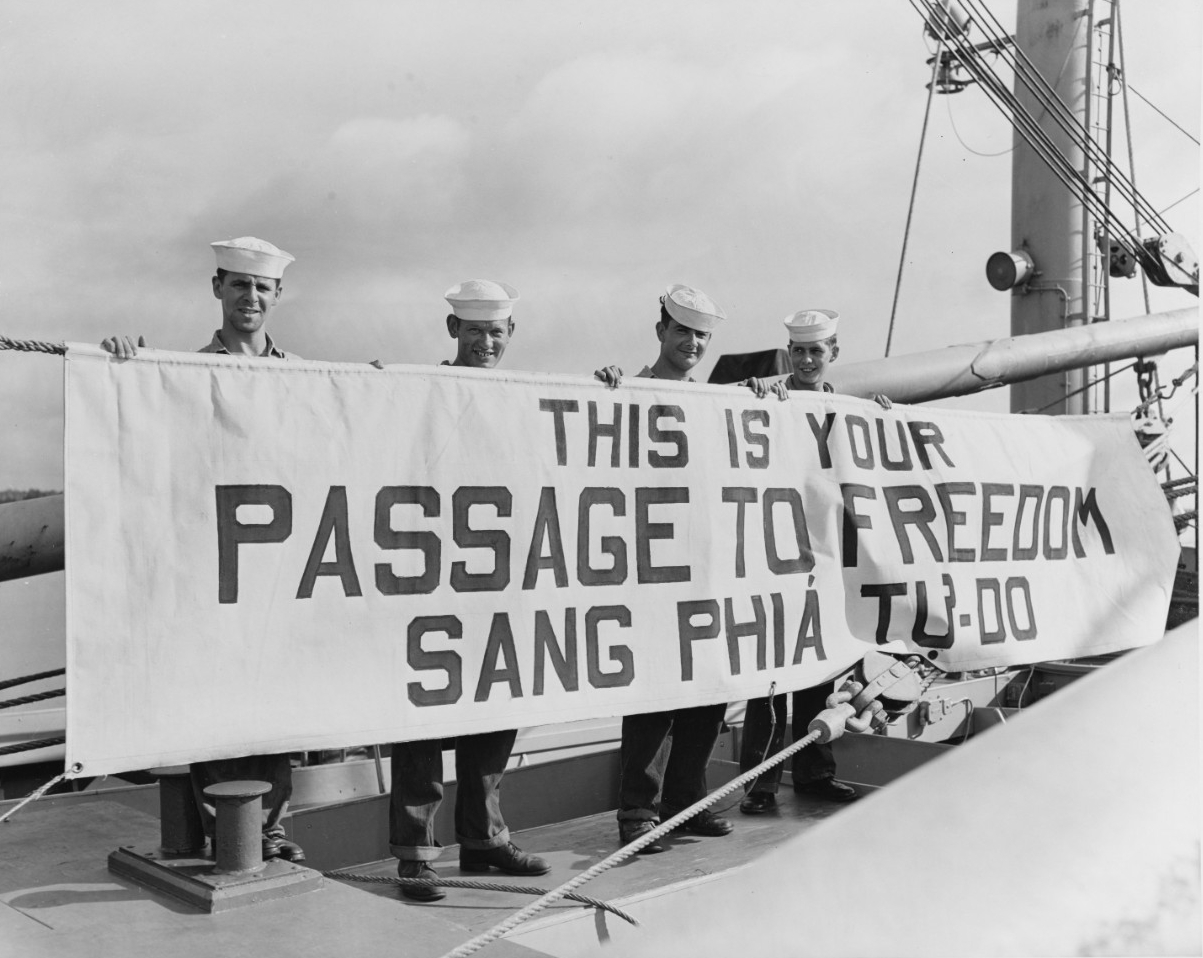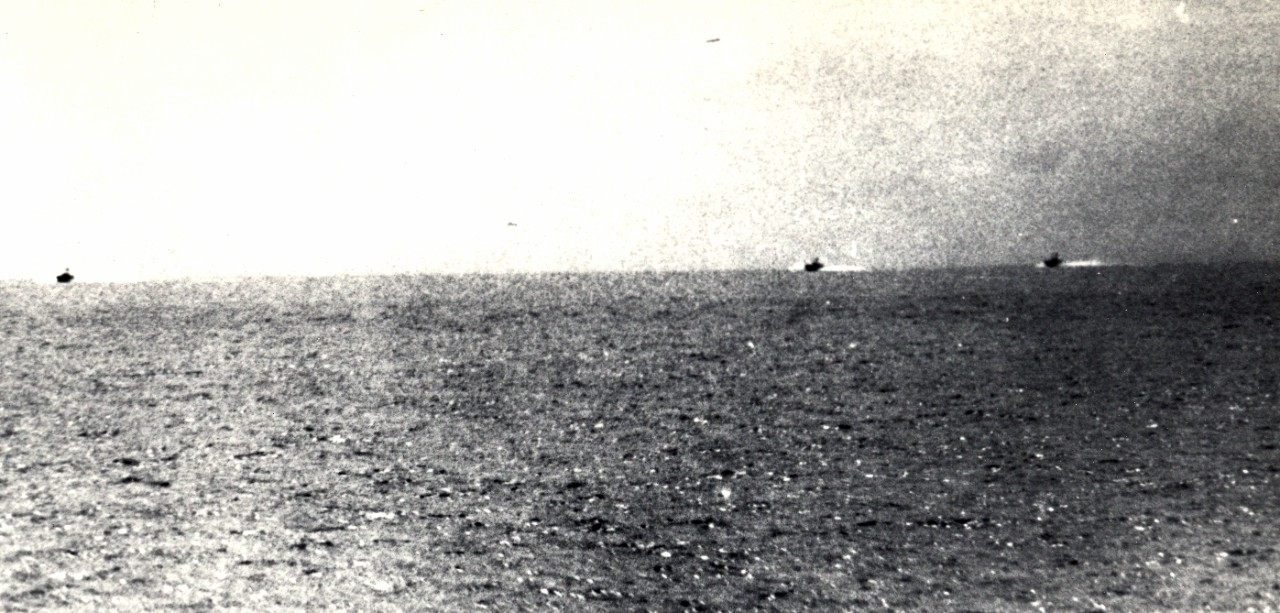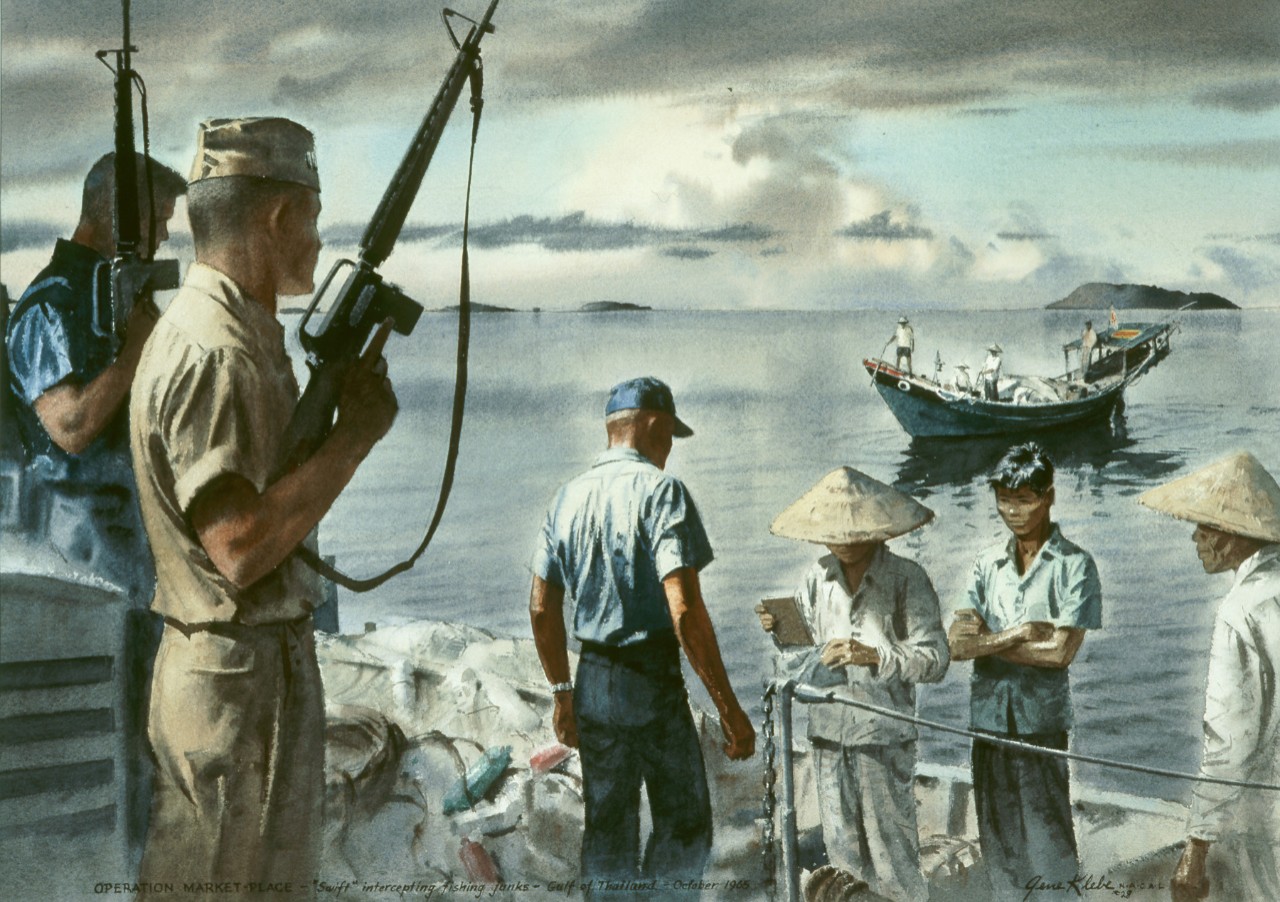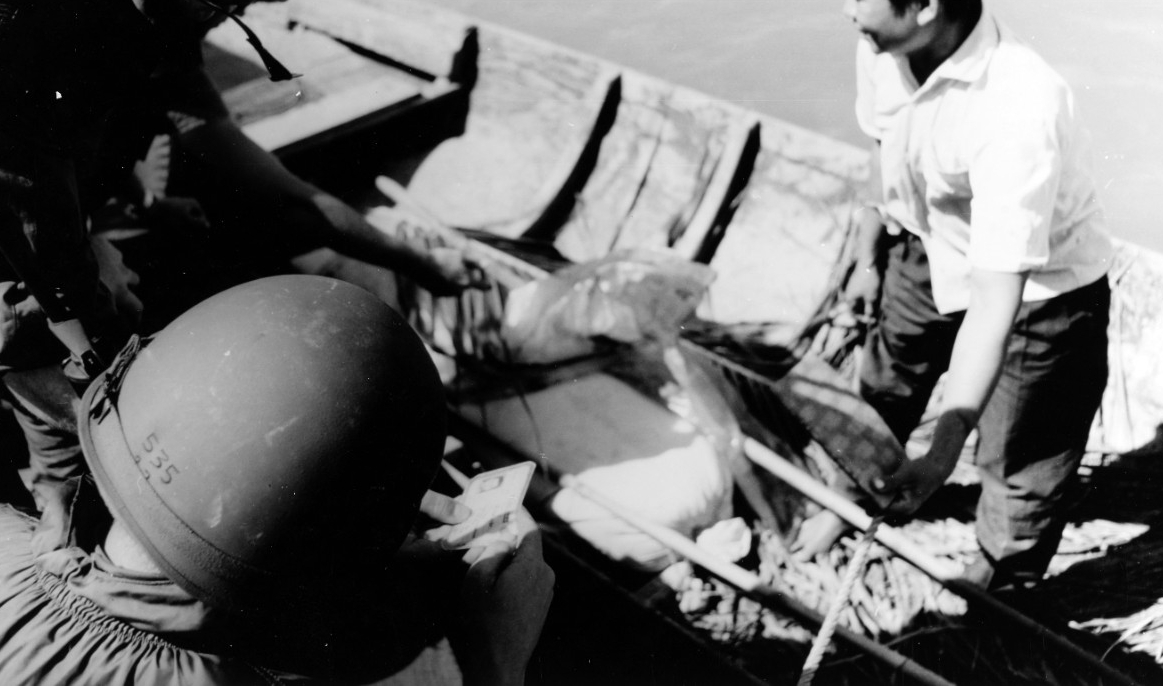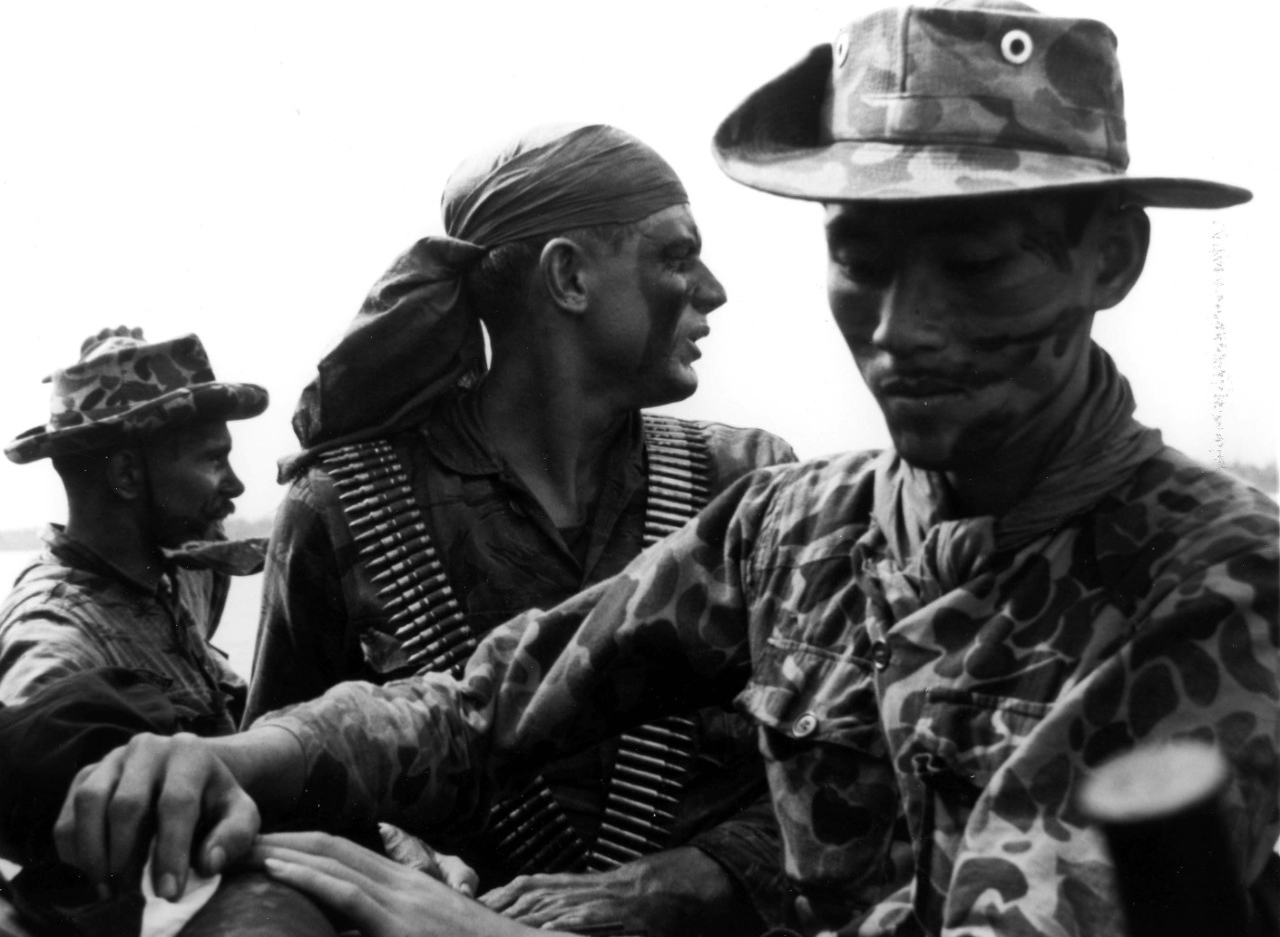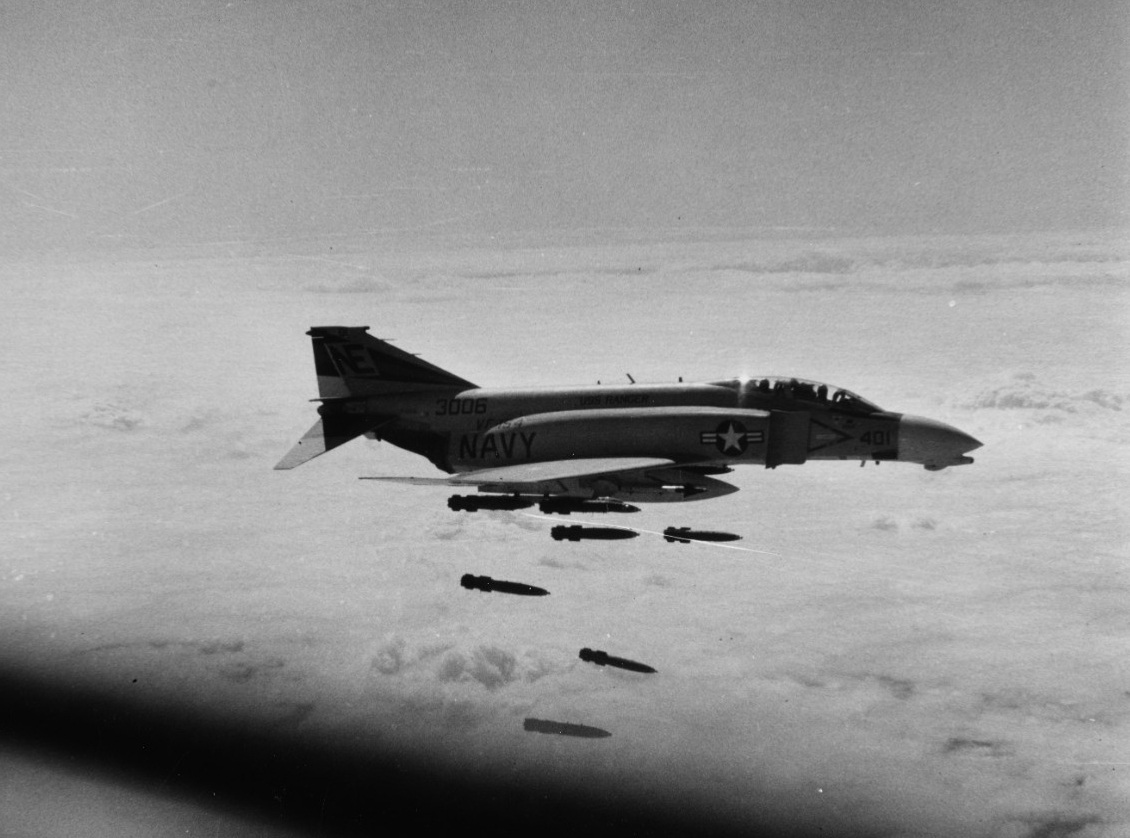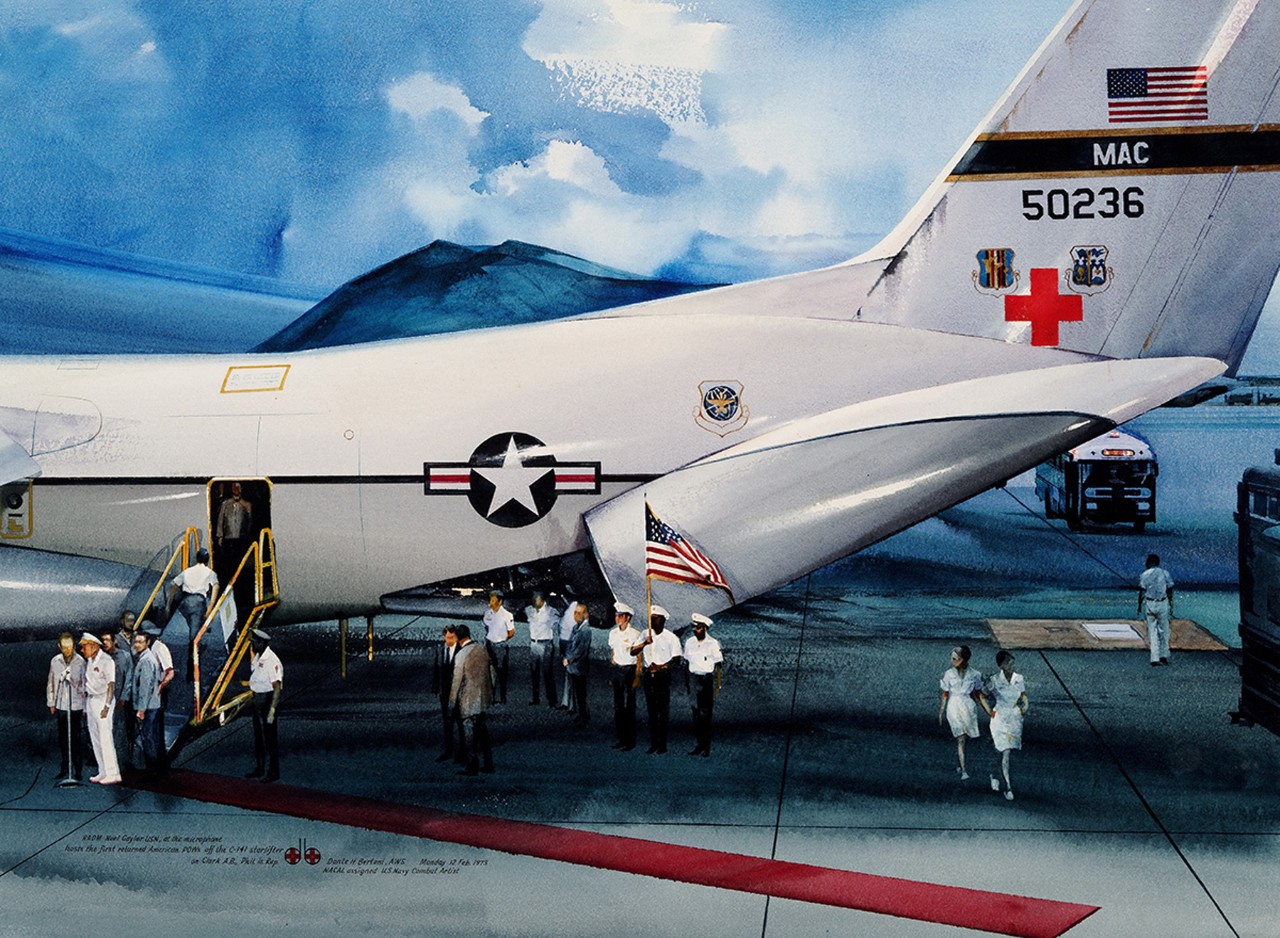A Chronology of the U.S. Navy in Vietnam and Southeast Asia, 1950–75
The following chronology includes major U.S. Navy operations and other events of historical and human interest related to the naval service that took place in Southeast Asia between 1950, when the United States first engaged militarily in what was then French Indochina, and 1975, when the fall of anti-communist governments in South Vietnam, Laos, and Cambodia occurred. The chronology is not all-encompassing. Smaller operations of limited duration and area, as well as many ongoing or recurring events such as gunfire-support and close air-support missions, civil affairs and reconstruction efforts, and logistics movements have not been included.Readers interested in these and other types of U.S. Navy engagement in the conflict are invited to explore the extensive primary-source material and NHHC publications on the Vietnam War “Operations” page.
1950
3 August: Arrival of U.S. Military Assistance Advisory Group (MAAG), Indochina, in Saigon to administer material assistance program to French Union forces; MAAG’s small Naval Section (initially eight officers and men) also oversees development of base facilities.
1954
7 May: Climactic French defeat at Dien Bien Phu; ultimately leads to July 1954 Geneva Accords, which ends French colonial rule and partition Vietnam at the 17th parallel.
August: Geneva Accords allows 300 days of free movement between (communist-controlled) North and (non-communist) South Vietnam. Refugees swamp Hanoi and Haiphong, seeking evacuation to the south. In response, U.S. Navy Task Force 90 is constituted in the Philippines from tank landing ships (LSTs) and cargo vessels. The seaborne portion of Operation Passage to Freedom, which included U.S., French, British, Taiwanese, and Polish ships, begins.
17 August: USS Menard (APA-201) is first Navy vessel to leave Haiphong for South Vietnam, embarking 1,924 refugees. The record for the most passengers taken in one three-day voyage was set by USS General W. M. Black (AP-135), which sailed on 29 October with 5,224 Vietnamese aboard.
December: U.S.–French combined Training Relations Instruction Mission (TRIM) established; TRIM has responsibility for training nascent South Vietnamese forces, including the Vietnam Navy (ultimately, Sea Force, Coastal Force, and River Force).
1955
February: U.S. Military Assistance Advisory Group, Vietnam, takes over training of South Vietnamese forces from Training Relations Instruction Mission. Direct French involvement in training mission ends.
18 May: Operation Passage to Freedom ends. In ten months, the U.S. Navy transported nearly 310,000 refugees from North to South Vietnam. An estimated 760,000 to 1 million refugees managed to flee North Vietnam by land, sea, or air before the Geneva Accords–mandated deadline.
1956
April: Last French forces and advisers leave South Vietnam. All remaining French naval patrol assets—primarily riverine and coastal craft—transferred to the Vietnam Navy prior to this date. Transition is overseen by Temporary Equipment Recovery Mission, which included U.S. Navy and Marine Corps personnel.
1959
May: U.S. military advisers authorized to accompany Vietnamese units on operations. Although an obvious escalation of U.S. involvement in Vietnam, this step reflected the South Vietnamese military’s ongoing failure to show much progress in its operational capabilities despite intensive U.S. training efforts and inflow of modern weapons.
September: Seventh Fleet assets deployed to South China Sea to deter communist guerilla (Pathet Lao) attacks on U.S.-allied government of Laos. Deployments and overflights continue until 8 May 1961, when a Laos cease-fire agreement is brokered. (This agreement was barely to last a year. Laos subsequently became a primary North Vietnamese supply conduit to communist forces in South Vietnam and also attained the tragic distinction of becoming one of the most heavily bombed countries in the world.)
1962
July: First deployment of U.S. Navy SEALs to Vietnam.
1964
April: USS Kitty Hawk (CVA-63) is first carrier on Yankee Station (in Gulf of Tonkin off of Vietnamese coast), initially in support of aerial reconnaissance missions flown over Laos. During the two periods of sustained air operations against North Vietnam (2 March 1965 to 31 October 1968, and 30 March 1972 to 29 December 1972), there were normally three carriers on station (Task Force 77), operating on alternating 12-hour schedules. Dixie Station, off of South Vietnam’s Mekong River delta, was used for single-carrier operations between 15 May 1965 and 3 August 1966.
15 May: U.S. Military Assistance Advisory Group, Vietnam, and its Naval Section was disestablished and absorbed by Military Assistance Command, Vietnam (MACV). The Naval Advisory Group (NAG) of MACV assumed the responsibilities of the former Naval Section. By end of year, 254 Sailors were assigned to MACV and NAG.
2, 4 August: Gulf of Tonkin incidents. On 2 August, USS Maddox (DD-731), on a signals intelligence patrol in the Gulf of Tonkin, was pursued by three North Vietnamese P-4 torpedo boats. Maddox fired warning shots; the P-4s responded with machine-gun fire and torpedoes. In the ensuing engagement, Maddox expended more than 280 3- and 5-inch shells. A second encounter supposedly occurred on 4 August, involving both Maddox and USS Turner Joy (DD-951). Although this was later shown to have been based on erroneous contact reports, the first and second incidents led to retaliatory air attacks on North Vietnam and the so-called Tonkin Gulf Resolution of 7 August, which greatly broadened President Lyndon B. Johnson’s military options in South Vietnam.
5 August: Lieutenant Junior Grade Everett Alvarez Jr., A-4 Skyhawk pilot from VA-144, USS Constellation (CVA-64), was shot down over North Vietnam. Alvarez was the first naval aviator captured by the North Vietnamese and the longest-held U.S. POW. After spending 3,113 days in captivity, he was released on 12 February 1973 as part of the first group of American POWs repatriated under Operation Homecoming.
30 November: Earliest Navy Cross award action in Vietnam: Lieutenant Harold Dale Meyerkord, senior U.S. Navy adviser to South Vietnamese 23rd River Assault Group. Actual decoration was posthumous; in 1969, USS Meyerkord (DE-/FFG-1058) was named in his honor.
1965
2 March: Operation Rolling Thunder, a gradual and sustained joint bombing campaign against North Vietnamese targets, begins. The evolving objectives of the operation were to boost the morale of the South Vietnamese government, to force North Vietnam to cease its support for the Viet Cong guerillas in South Vietnam (without deploying U.S. and allied ground forces into North Vietnam), to destroy North Vietnam’s transportation system, industrial base, and air defenses, and to halt the flow of men and material into South Vietnam. Rolling Thunder continued at varying levels of intensity until 2 November 1968 following North Vietnamese agreement to meet with U.S. negotiators in Paris.
8 March: Seventh Fleet Amphibious Force units land 3rd Battalion, 9th Marines, at Danang, South Vietnam—the first battalion-size U.S. ground combat unit deployed ashore in Southeast Asia.
11 March: Operation Market Time commences. Market Time was the combined U.S. and South Vietnamese naval blockade of the South Vietnamese coast to prevent seaborne supplies from reaching Viet Cong guerillas. The operation continued for eight and and half years and denied the North Vietnamese a means of bringing hundreds of tons of materiel into South Vietnam by sea.
24 March: Vietnam Patrol Force (Task Force 71) established; U.S. component of Operation Market Time is under operational control of Seventh Fleet. The coastal forces were augmented by larger, radar-picket destroyer escorts (DERs) that patrolled seaward boundaries of the 1,000-mile-long operational area and by U.S. Navy patrol aircraft flying from South Vietnam, the Philippines, and Thailand.
July: U.S. Coast Guard 82-foot “Point”-class patrol boats (WPBs) deployed to Vietnam to augment Task Force 71 (TF-71) interdiction efforts. Ultimately, USCG Squadrons 1 and 3 were assigned to TF-71.
30 July: Task Force 71 inactivated; operational control of most Market Time assets shifted from Seventh Fleet to Task Force 115, part of the Naval Advisory Group.
9 September: Then-Commander James Stockdale, A-4 Skyhawk pilot and Commander Air Group 16, USS Oriskany (CV-34), was shot down over North Vietnam. Stockdale was the senior U.S. POW held by the North Vietnamese. On 6 March 1976, he was awarded the Medal of Honor for his unfaltering leadership of other POWs during seven and a half years of grueling captivity.
October: First deployment of fast coastal patrol boats (PCFs—“Swift” boats) to Vietnam.
18 December: Operation Game Warden begins; U.S. Navy component is Task Force 116 (TF-116). The operation targeted enemy movement of personnel, weapons, and supplies on South Vietnam’s extensive network of inland waterways. At the operation’s height in October 1968, TF-116 had a total of 2,032 personnel and 288 craft on South Vietnam’s rivers and canals.
1966
March: First deployment of river patrol boats (PBRs) in Vietnam.
28 March: Hospital Corpsman Third Class Robert R. Ingram, assigned to Company C, 1st Battalion, 7th Marines, is the first Sailor awarded the Medal of Honor for actions in Vietnam, and the first of 16 such awards to U.S. Navy personnel during the conflict.
1 April: Due to the increase of U.S. forces in South Vietnam, Commander, Naval Forces Vietnam (COMNAVFORV) was established at Naval Support Activity Saigon. The Naval Advisory Group was subordinate to COMNAVFORV, who, in turn, was subordinate to the theater commander, Commander in Chief, Pacific Command (CINCPAC).
30 June: Navy Cross awarded to Lieutenant Junior Grade Dieter Dengler, A-1H Skyraider pilot from VA-145, USS Ranger (CVA-61), following his escape from a Pathet Lao prison camp. Dengler was the first U.S. POW to escape captivity in Southeast Asia.
19 August: Radarman Second Class Billy Machen, SEAL Team 1, killed in action during a reconnaissance patrol; the first U.S. Navy SEAL combat casualty in Vietnam.
25 October: Operation Sea Dragon begins in waters off of the demilitarized zone at the 17th parallel. The operation combined naval gunfire missions, interdiction of North Vietnamese sea lines of communications, and support of covert CIA agent-extraction missions. Sea Dragon continued into October 1968.
1967
The CIA-led Phoenix Program, which evolved out of earlier, less-broad-based operations, was initiated during the course of the year. It specifically targeted Viet Cong cadre and infrastructure, and involved U.S. intelligence and special operations units (including U.S. Navy SEALs), South Vietnamese security forces, and Australian special operations teams. Officially, the effective but controversial program was ended in December 1972; however, certain operations continued into 1975.
May: Joint U.S. Navy–U.S. Army Mobile Riverine Force (MRF–Task Force 117) established. The MRF was conceived as a “strike force” augmenting Task Forces 115 and 116, and operated in the Mekong River delta region. It was comprised of a reinforced brigade of the Army’s 9th Infantry Division and, ultimately, four Navy assault squadrons. These included landing craft, armored command and fire-support craft, air-cushion vehicles, and a floating riverine base composed of barracks barges and supply ships. Air assets included light Navy attack helicopters.
29 July: Near-catastrophic fire onboard USS Forrestal (CVA-59) on Yankee Station. The fire killed 134 service members, injured 161, and destroyed 21 aircraft. It was second-worst loss of life on a U.S. Navy ship since World War II.
26 October: Then–Lieutenant Commander John S. McCain III, flying a VA-46 A-4 Skhawk off USS Oriskany (CV-34), was shot down by a North Vietnamese SA-2 “Guideline” ground-to-air missile. As a POW, the later prominent U.S. senator endured repeated torture, constant ill-treatment, and deprivation until he was released on 14 March 1973 in Operation Homecoming.
1968
21 January–11 July: Battle of Khe Sanh; combat base with 6,000 Marines of the 3rd Marine Division is besieged by North Vietnamese forces. In Operation Niagara, U.S. Navy, U.S. Marine Corps, and U.S. Air Force air assets dropped more bombs around Khe Sanh than were dropped in the entire Korean War or in air attacks against Japan in 1945. The bombing and close air support missions were instrumental in preventing a North Vietnamese all-out assault on the base. Moreover, sensors dropped by Special Naval Observation Squadron 67 (VO-67) provided the Khe Sanh defenders with much-needed intelligence about enemy troop movements.
30 January: North Vietnamese and Viet Cong forces begin the Tet Offensive. Naval Support Activity Saigon, many of its detachments, and many other in-country U.S. Navy bases were attacked. Tet-related actions continued into that September. Despite the U.S./South Vietnamese tactical victory, which inflicted heavy Viet Cong casualties, Tet was ultimately a strategic loss since it laid bare weaknesses in U.S. political and military strategy, and the fragility of the South Vietnamese government.
5 November: SEALORDS (Southeast Asia Lake, Ocean, River, and Delta Strategy—Task Force 194) launched by then–Commander, Naval Forces Vietnam Vice Admiral Elmo R. Zumwalt Jr. The strategy was intended to interdict waterborne enemy supplies in areas of the Mekong River delta not extensively covered by other operations, specifically along the Cambodian border. Task Force 194 (TF-194) assets included Swift boats, PBRs, river minesweepers, Coast Guard cutters, and light fixed- and rotary-wing U.S. Navy aircraft. TF-194 operations and many of its assets were officially turned over to the Vietnam Navy in April 1971.
1969
28 January: First conceptualization by policy makers of “Vietnamization.” According to then–Secretary of Defense Melvin R. Laird, this transitional program was intended to “expand, equip, and train South Vietnamese forces and assign to them an ever-increasing combat role, at the same time steadily reducing the number of U.S. combat troops.” In-country U.S. Navy forces also took part in this process, with most units turning over their missions and assets to the Vietnam Navy by late 1972. Pressure on North Vietnam was later maintained with the combined U.S.–South Vietnamese incursion into Cambodia in April 1970 and the 1972 Linebacker bombing operations.
1972
9 May: Operation Linebacker, a joint (U.S. Navy Task Force 77 and U.S. Seventh Air Force) air-interdiction campaign against North Vietnam, began. It grew from air attacks in response to the March 1972 North Vietnamese offensive to a concerted campaign to isolate North Vietnam from its outside sources of supply by destroying railroad bridges and rolling stock in and around Hanoi and northeastward toward the Chinese frontier; targeting primary storage areas and marshalling yards; destroying storage and transshipment points; and finally, by eliminating (or at least damaging) the enemy’s air defense system. Linebacker was the first bombing operation to utilize precision-guided munitions on a wide scale and was instrumental in bringing the North Vietnamese back to the negotiating table in the Paris cease-fire talks that August. Linebacker ended on 23 October.
1973
27 January: Paris ceasefire accords signed by U.S. and North Vietnamese officials. According to a protocol to the agreement, the United States began to neutralize the mines that the Navy had dropped in North Vietnam’s coastal and inland waterways. Operation Endsweep, conducted by Seventh Fleet surface and air mine-warfare assets, lasted until 18 July.
12 February: Paris accords stipulated the return of U.S. POWs by North Vietnam within two months. Among those returning to the United States with Operation Homecoming through that March were 138 naval aviators downed over North Vietnam. Of the 178 naval personnel held by the North Vietnamese, 36 had died in captivity.
26 March: Commander, Naval Forces Vietnam (COMNAVFORV) disestablished.
15 August: Direct U.S. military involvement in the conflict ends.
1975
30 April: Last U.S. Marines evacuated from U.S. embassy compound in Saigon; city subsequently falls to North Vietnamese forces. Seventh Fleet aided the near-overwhelming number of seaborne South Vietnamese refugees and surviving Vietnam Navy units.
12 May: U.S.-flagged container ship Maguayez seized by Cambodian communist Khmer Rouge forces in Gulf of Thailand (less than a month after the Khmer Rouge defeat of the U.S.-backed Cambodian government). The subsequent rescue operation, which involved a joint assault of U.S. Navy, U.S. Marine Corps, and U.S. Air Force units on the Cambodian island of Koh Tang, was the last battle of the Vietnam War.
Selected References
Publications
Thomas J. Cutler, Brown Water, Black Berets: Coastal and Riverine Warfare in Vietnam. Annapolis, MD: Naval Institute Press, 1988.
Edward J. Marolda, By Sea, Air, and Land: An Illustrated History of the U.S. Navy and the War in Southeast Asia. Washington, DC: Department of the Navy/Naval Historical Center, 1994.
John Darrell Sherwood, War in the Shallows: U.S. Navy Coastal and Riverine Warfare in Vietnam, 1965–1968. Washington, DC: Department of the Navy/Navy History and Heritage Command, 2015.
NHHC Series: The U.S. Navy and the Vietnam War
Edward J. Marolda, The Aproaching Storm: Conflict in Asia, 1945–1965. Washington, DC: Department of the Navy/Naval Historical Center, 2009.
John Darrell Sherwood, Nixon's Trident: Naval Power in Southeast Asia, 1968–1972. Washington, DC: Department of the Navy/Naval Historical Center, 2009.
Stuart I. Rochester, The Battle Behind Bars: Navy and Marine POWs in the Vietnam War. Washington, DC: Department of the Navy/Naval Historical Center, 2010.
Jan K. Herman, Navy Medicine in Vietnam: Passage to Freedom to the Fall of Saigon. Washington, DC: Department of the Navy/Naval Historical Center, 2010.
Edward J. Marolda and R. Blake Dunnavent, Combat at Close Quarters: Warfare on the Rivers and Canals of Vietnam. Washington, DC: Department of the Navy/Naval History and Heritage Command, 2015
Norman Polmar and Edward J. Marolda, Naval Air War: The Rolling Thunder Campaign. Washington, DC: Department of the Navy/Naval History and Heritage Command, 2015.
Richard A. Mobley and Edward J. Marolda, Knowing the Enemy: Naval Intelligence in Southeast Asia. Washington, DC: Department of the Navy/Naval History and Heritage Command, 2015.
Salvatore R. Mercogliano, Fourth Arm of Defense: Sealift and Maritime Logistics in the Vietnam War. Washington, DC: Department of the Navy/Naval History and Heritage Command, 2017.
Malcolm Muir, Jr., End of the Saga: The Maritime Evacuation of South Vietnam and Cambodia. Washington, DC: Department of the Navy/Naval History and Heritage Command, 2017.
—Carsten Fries, NHHC Communication and Outreach Division, March 2018


